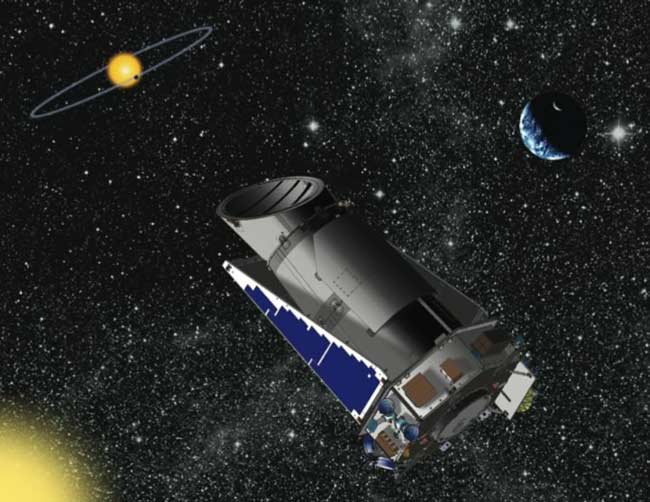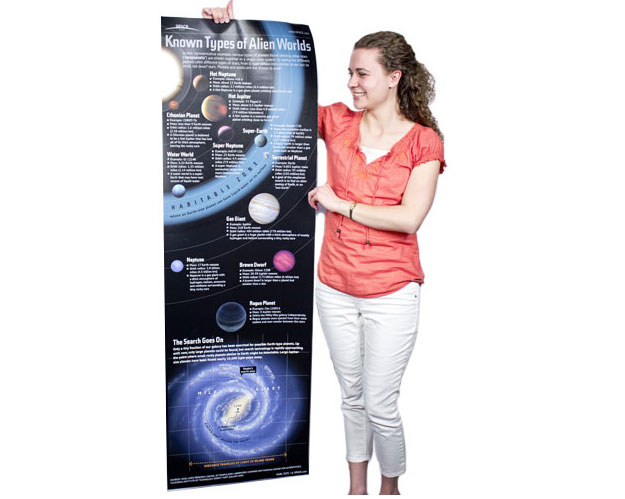NASA's Planet-Hunting Kepler Spacecraft Faces Serious Health Problems

Health issues are jeopardizing the planet-hunting work of NASA's prolific Kepler space telescope, which has identified more than 2,700 potential alien worlds to date.
One of Kepler's reaction wheels — devices that maintain the observatory's position in space — remains balky despite mitigation attempts. The mission team now regards the problem as unsolvable and is considering what the telescope can do after the wheel fails.
"While the wheel may still continue to operate for some time yet, the engineering team has now turned its attention to the development of contingency actions should the wheel fail sooner, rather than later," Kepler mission manager Roger Hunter, of NASA's Ames Research Center in Moffett Field, Calif., wrote in an update Monday (April 29). [Gallery: A World of Kepler Planets]
Staring at stars
The $600 million Kepler observatory detects exoplanets by flagging the tiny brightness dips caused when they pass in front of their host stars from the instrument's perspective. Kepler's main goal is to determine how common Earth-like alien planets are throughout the Milky Way galaxy.
The spacecraft needs three functioning reaction wheels to stay locked onto its 150,000-odd target stars. Kepler had four wheels when it launched in March 2009 — three for immediate use, and one spare. But one wheel (known as number two) failed in July 2012, giving Kepler no margin for error.
The currently glitchy wheel (known as number four) has acted up before, but its problems now seem more serious, mission officials said.
Breaking space news, the latest updates on rocket launches, skywatching events and more!
"The part that worries us is that the elevated friction that we're seeing in wheel number four now is very reminiscent of what we saw a year ago in wheel number two, which eventually failed," said Kepler deputy project manager Charlie Sobeck, also of NASA Ames.
"Wheel two had elevated friction for about six months, a little bit more than that, before it finally failed," Sobeck told SPACE.com. "Now we're going on four months of elevated friction here on wheel number four. So we're certainly concerned that we may be on the same kind of path here."
Engineers gave the wheel a 10-day rest in January, hoping the break would redistribute lubricant and bring friction back down to normal levels. But the fix appears not to have worked.
"Kepler’s reaction wheel #4 continues to exhibit signs of elevated friction levels and occasional torque spikes that appear to indicate a deterioration of the wheel bearing," Hunter wrote in Monday's update.
Still hunting for exoplanets
The Kepler team's top priority at the moment is gathering data while the observatory is still at full strength, Sobeck said, because it's unclear how much longer wheel number four will last.
"Right now, the data is still great," Sobeck said. "Nothing's more important than continuing to get high-quality data while we still can."
If and when wheel number four fails, the mission team will likely try to recover it and wheel number two, he added.
"Maybe we can just turn these wheels and power through whatever deterioration there is," Sobeck said. "That may be sufficient; we don't know."
But Kepler's mission will likely change if such recovery actions don't work. The observatory probably won't be able to continue its "point-and-stare" search for exoplanets with only two working wheels, so it will have to switch to some type of scanning operations, Sobeck said.
The team has begun thinking about what a new scanning mode might be able to accomplish. Researchers are also trying to figure out ways to conserve fuel, so Kepler can keep operating for as long as possible if it needs to start using its thrusters to help point at targets.
Discoveries will keep rolling in
Kepler has been an incredibly successful mission by pretty much any measure, researchers say.
The observatory has spotted more than 2,700 planet candidates to date. Just 122 of these worlds have been confirmed by follow-up observations so far, but mission scientists estimate that more than 90 percent will end up being the real deal.
The telescope has also outlasted its prime mission life of 3.5 years; it's currently working on an extended mission that takes it through at least fiscal year 2016.
Reducing the observatory to two working reaction wheels won't stop the flood of Kepler exoplanet discoveries — such as the potentially life-supporting worlds Kepler-62e and Kepler-62f, which were announced earlier this month — at least not for a while.
"We've really only sort of looked at half the dataset so far. We just haven't had the time and the processing hours to go through it all," Sobeck said. "If the Kepler spacecraft were to stop working today, the scientific output of the mission would continue for at least another year or two before you would see a dropoff."
Follow Mike Wall on Twitter @michaeldwall and Google+. Follow us @Spacedotcom, Facebook or Google+. Originally published on SPACE.com.

Michael Wall is a Senior Space Writer with Space.com and joined the team in 2010. He primarily covers exoplanets, spaceflight and military space, but has been known to dabble in the space art beat. His book about the search for alien life, "Out There," was published on Nov. 13, 2018. Before becoming a science writer, Michael worked as a herpetologist and wildlife biologist. He has a Ph.D. in evolutionary biology from the University of Sydney, Australia, a bachelor's degree from the University of Arizona, and a graduate certificate in science writing from the University of California, Santa Cruz. To find out what his latest project is, you can follow Michael on Twitter.


